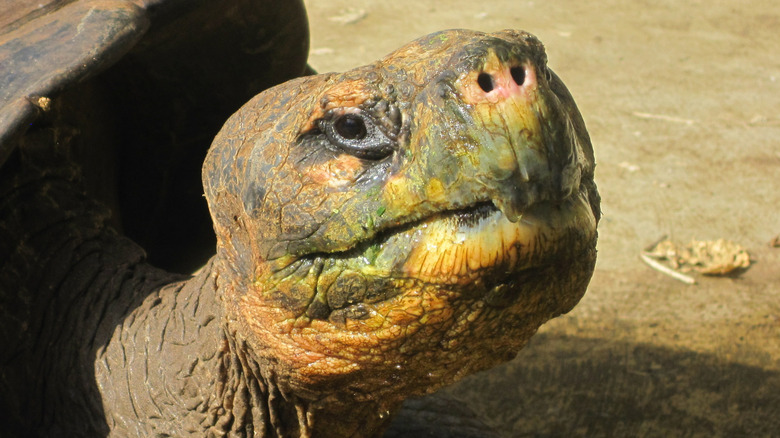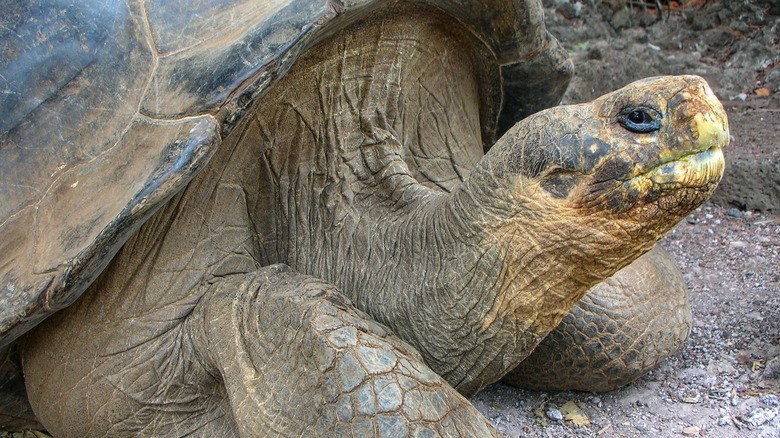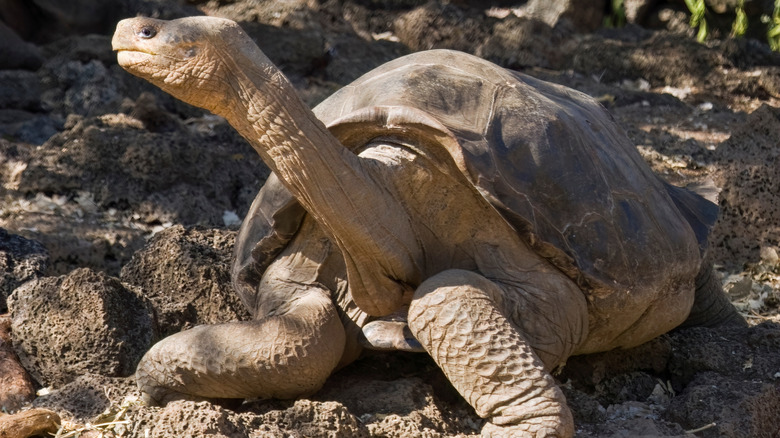The Pinta Giant Tortoise Went Extinct After This Heartbreaking Death
Nobody likes the idea of animals going extinct, but this ongoing issue becomes even more alarming when you look into it. Today, there are numerous creatures that are on the brink of extinction and plenty of animals that went extinct in the last decade alone — one of which is the Pinta giant tortoise (Chelonoidis abingdonii).
Also known as the Pinta Island tortoise, the species originates from the island of Pinta in the northern regions of the Galápagos Archipelago, where it was the only species of giant tortoise on the island. The Pinta giant tortoise was actually fairly common right up until the 1850s, but numbers dwindled after that due to the animals being killed by whalers and buccaneers and the introduction of goats which competed with the tortoises for land and food. As a result, the Pinta giant tortoise became extremely rare until there was just one known example of the species in the world. Sadly, the poor creature passed away in 2012, and with him went the entire Pinta giant tortoise species.
George the tortoise was the last member of his species
After a century of giant tortoises being exploited by whalers and other mariners, the Pinta giant tortoise was thought to have gone extinct in the early 20th Century. But in 1971, a Hungarian scientists named József Vágvölgyi discovered a lone Pinta giant tortoise while studying snails on the island. This lone example of the species became known as Lonesome George, reportedly after the comedian George Gobel, and represented the last individual from one of 10 surviving giant tortoise species from the Galápagos Archipelago.
In 1972, George was taken to a new home at the Tortoise Breeding and Rearing Center in Puerto Ayora, Santa Cruz Island. The center, which sits off the coast of Santa Barbara, California, was George's home for the next 40 years, during which time staff made numerous attempts to breed the lonely tortoise. Initially, it was hoped that a female Pinta giant tortoise could be found, but it soon became clear that wasn't going to happen, so staff turned their attention to bringing female Wolf Volcano giant tortoises — at the time thought to be the most genetically similar species — to George. Sadly, the old boy didn't produce any viable offspring. Then, conservationists ran out of time.
On June 24th, 2012, Galápagos National Park Service members found George dead in his pen. He was thought to have been more than 100 years old. After the species was assessed for The International Union for Conservation of Nature Red List of Threatened Species, the Pinta Island tortoise was officially declared extinct in 2015. Extensive surveys were carried out in order to try to identify another Pinta giant tortoise on Pinta Island or in zoos around the world, but not a single one turned up another example of the species. That confirmed George as the last member of his species
Could the Pinta giant tortoise return from extinction?
Despite the species going extinct with George, there may be a small chance the Pinta giant tortoise could return. When mariners and whalers were snatching up giant tortoises in the 19th Century, they would often throw unwanted tortoises overboard in a harbor named Banks Bay, on Isabela Island, the largest of the Galápagos Islands. In 2013, researchers went looking for Pinta giant tortoise DNA in the wild and published their findings in the journal Biological Conservation. The team focused their efforts on Isabela Island, where hybrid tortoises were known to exist, and discovered 17 tortoises with C. abingdonii genes.
The researchers claimed that this presented an opportunity to recover the Pinta Island tortoise species, but recent ostensibly successful attempts to do the same with the dire wolf have proven controversial. Science also plans to bring the Tasmanian tiger back from extinction, but again, it's not entirely clear if the resulting animals will represent true examples of the species.
Meanwhile, the body of Lonesome George has been preserved and after being featured in an exhibition at the American Museum of Natural History in 2014, was returned to the Galápagos Islands in 2017 to be displayed in the Fausto Llerena Breeding Center. Inscribed outside George's enclosure are the words, "Whatever happens to this single animal, let him always remind us that the fate of all living things on Earth is in human hands." It's a moving message and a stark reminder of our immense responsibility to animals — though the fate of all living things isn't necessarily in human hands, considering that in the distant future the sun will slowly expand and destroy all life in its vicinity and we face numerous threats from outer space, including gamma-ray bursts, about which there's little we can do. Still, the point stands.


